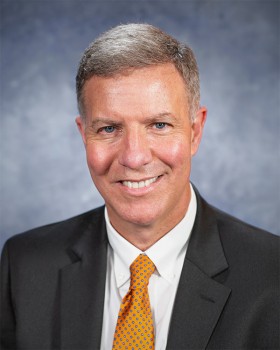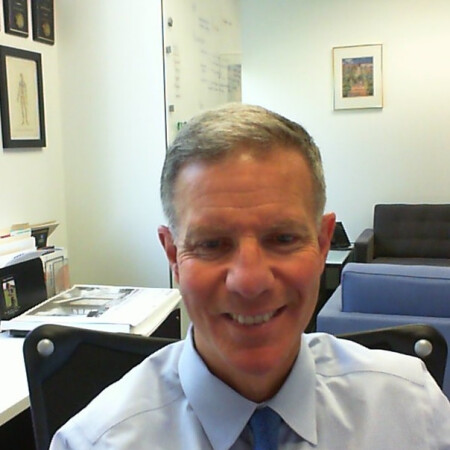Ph.D. - Biomedical Engineering
University of Virginia - 1990
Professional Preparation
M.S. - Biomedical Engineering
University of Virginia - 1988
University of Virginia - 1988
B.S. - Electrical Engineering
University of Illinois - 1984
University of Illinois - 1984
Research Areas
Research interests involve neural interfaces and neurotechnologies ranging from implantable devices to novel approaches for labile free assays for neuroactive compounds. My work is primarily focused on the development and demonstration of innovative materials that either enhance the coupling with neuronal tissue, show enhanced reliability, and/or reduce the deleterious effects on surrounding biotic environment.Publications
Antioxidant Dimethyl Fumarate Temporarily but not Chronically Improves Intracortical Microelectrode Performance - Working Paper
Piezo1 and Piezo2 Ion Channels in Neuronal and Astrocytic Responses to MEA Implants in the Rat Somatosensory Cortex 2025 - Journal Article
Softening, Conformable, and Stretchable Conductors for Implantable Bioelectronics Interfaces 2025 - Journal Article
Enhanced Performance of Novel Amorphous Silicon Carbide Microelectrode Arrays in Rat Motor Cortex 2025 - Journal Article
Softening, Conformable, and Stretchable Conductors for Implantable Bioelectronics Interfaces 2024 - Journal Article
In Vitro Pharmacological Modulation of PIEZO1 Channels in Frontal Cortex Neuronal Networks 2024 - Journal Article
Real-Time Assessment of Rodent Engagement Using ArUco Markers: A Scalable and Accessible Approach for Scoring Behavior in a Nose-Poking Go/No-Go Task 2024 - Journal Article
NeurostimML: a machine learning model for predicting neurostimulation-induced tissue damage 2024 - Journal Article
Awards
Invited Journal Referee - American Journal of Physiology, Anesthesiology, Annals of Biomedical Engineering, Biophysical Journal, Bioinformatics, Biosensors and Bioelectronics, Cancer Research, IEEE Transactions in Biomedical Engineering, Journal of Applied Biomaterials & Biomechanics, Journal of Intelligent Material Systems and Structures, Nature Biotechnology, Journal of Neural Engineering, Journal of Neurophysiology, Journal of Neuroscience, Journal of Pharmacology and Experimental Therapeutics, Nature Nanotechnology, Nature Neuroscience, Neuropharmacology, Neurotoxicology, PlosOne, Trends in Biotechnology, etc.
Gold Electrode Award 2016 - [2016]
Speaker for Debate on Neurotechnology for Neuroenhancement - AAAS and the Dana Foundation [2013]
National Chair - Neural Interfaces Conference Steering Committee [2012]
Organizing Committee Member and/or Session Moderator - Society for Environmental Toxicology and Chemistry's (SETAC) 22nd Annual Meeting, Cell and Tissue-Based Biosensors for Environmental Monitoring, Baltimore, MD [2011]
AIMBE Fellow - [2010]
Gold Electrode Award - [2009]
Organizing Committee Member and/or Session Moderator - Brain Pacemakers – a New Era of Hope for Neurological and Psychiatric Disorders, Office on Disability, US Department of Health and Human Services and the Cleveland Clinic Center for Neurological Restoration present, session moderator, Washington, DC [2008]
Organizing Committee Member and/or Session Moderator - Neural Interfaces Conference, co-chair, Cleveland, OH [2008]
Organizing Committee Member and/or Session Moderator - Neural Interfaces Conference Steering Committee [2008]
Appointments
Vice President for Research
The University of Texas at Dallas [2018–Present]
Richardson, TX
The University of Texas at Dallas [2018–Present]
Richardson, TX
Associate Provost
Department of Bioengineering, University of Texas at Dallas [2015–2018]
Richardson, TX
Department of Bioengineering, University of Texas at Dallas [2015–2018]
Richardson, TX
Professor
Department of Bioengineering, University of Texas at Dallas [2015–Present]
Richardson, TX
Department of Bioengineering, University of Texas at Dallas [2015–Present]
Richardson, TX
Professor
Department of Bioengineering, George Mason University [2011–2015]
Fairfax, VA
Department of Bioengineering, George Mason University [2011–2015]
Fairfax, VA
Founding Chair
Department of Bioengineering, George Mason University [2011–2015]
Fairfax, VA
Department of Bioengineering, George Mason University [2011–2015]
Fairfax, VA
Professor
Department of Electrical and Computer Engineering, George Mason University [2009–2015]
Fairfax, VA
Department of Electrical and Computer Engineering, George Mason University [2009–2015]
Fairfax, VA
Program Director
Neural Engineering, Extramural Research Program, National Institutes of Health/National Institute of Neurological Disorders and Stroke (NIH/NINDS) [2004–2009]
Bethesda, MD.
Neural Engineering, Extramural Research Program, National Institutes of Health/National Institute of Neurological Disorders and Stroke (NIH/NINDS) [2004–2009]
Bethesda, MD.
Head
Laboratory for Biomolecular Dynamics, Center for Bio/Molecular Science and Engineering, Naval Research Laboratory [2002–2004]
Washington, DC
Laboratory for Biomolecular Dynamics, Center for Bio/Molecular Science and Engineering, Naval Research Laboratory [2002–2004]
Washington, DC
Materials Research Engineer
Center for Bio/Molecular Science and Engineering, Naval Research Laboratory [1998–2002]
Washington, DC
Center for Bio/Molecular Science and Engineering, Naval Research Laboratory [1998–2002]
Washington, DC
Visiting Research Assistant Professor
Department Biochemistry and Molecular Biology, Georgetown University, [1997–1998]
Washington, DC
Department Biochemistry and Molecular Biology, Georgetown University, [1997–1998]
Washington, DC
Presentations
“Exploiting Polymeric Materials for Neural Interface Applications”
2016/05 at Neuromodulation: The Science (San Francisco, CA)“Neurotechnology and Neuroengineering”
2016/10 Texas Fresh AIR Grand Challenges in Neuroscience conference (Austin, TX)“New Advances and Trends in Neural Interfaces”
2016/10 at Neurotech Leaders Forum (San Francisco, CA)Panel Discussion: Engineering Robust Neural Interfaces
2017/02 Progress and Challenges, Persh Workshop “The Interface Between Materials and Biology” (Alexandria, VA)“Label Free Assays for Neural Function Based on Extracellular Recording”
2017/06 at Cell Culture and Therapy Conference (Philadelphia, PA)Additional Information
Hickman, J.J., Pancrazio, J.J. Neuroelectric computational devices and networks, Patent Number 6,654,729, issued: 11/25/2003.
Johnson, L., Scribner, D., Pancrazio, J.J. Microelectronic Cell Electroporation Array, Patent Number 7,521,224, issued: 04/24/2009.
Frewin, C.L., Register, J.J., Saddow, S.E., Pancrazio, J.J., Reyes-Natal, M. USF Ref. No. 14A033 - Technology Title: “Magnetic Resonance Imaging (MRI) Safe Deep Brain Stimulation (DBS)/ Pacemaker Stylus and Lead with Directed Stimulation and Feedback Capabilities”. Date of Disclosure: 3/5/2014.
News Articles
Joseph J. Pancrazio Appointed Vice President for Research
 Dr. Joseph J. Pancrazio, associate provost and professor of bioengineering at The University of Texas at Dallas, has been named vice president for research for the University.
Dr. Joseph J. Pancrazio, associate provost and professor of bioengineering at The University of Texas at Dallas, has been named vice president for research for the University. Effective June 1, the appointment was made after a national search that attracted exceptional candidates, said UT Dallas President Richard C. Benson.
“Dr. Pancrazio has a deep understanding of the issues and opportunities that are critical to maintain and expand a dynamic university research program,” Benson said. “His expertise is especially pertinent when it comes to conducting and overseeing interdisciplinary collaboration, which is one of the hallmarks of the UT Dallas research enterprise. I look forward to working with Dr. Pancrazio as we continue to attract top faculty members into our ranks, graduate highly skilled doctoral students and increase extramural research funding.”
Bioengineer Honored for Neurotechnology Research
Dr. Joseph Pancrazio, associate provost and bioengineeringprofessor at UT Dallas, has been named Neurotechnology Researcher of the Year for 2016 by the industry newsletter Neurotech Reports.Neurotech Reports editor James Cavuoto said the organization looked at Pancrazio’s academic and research accomplishments, and his impact on the development and maturation of the neurotechnology industry. Neurotechnology is used to understand and influence the brain and nervous system for the purposes of improving health, education and information technology.
Researchers Devise Decoy Molecule to Block Pain Where It Starts
This study was supported by a $2 million, five-year grant from the National Institutes of Health to study RNA-binding proteins in peripheral neurons. Price and Dr. Joseph Pancrazio, a professor in the Department of Bioengineering in the Erik Jonsson School of Engineering and Computer Science, are collaborators on the grant.Jonsson School Builds Bigger Roster of Researchers, Engineers
“With the significant research infrastructure, collaborative colleagues across multiple disciplines, and exceptional students, I look forward to contributing to the continued growth of bioengineering at UT Dallas — especially in the area of bioelectronics.”Activities
PhD Thesis Committee Member
Shakil Mohammed, Material Sciences and Engineering, 2016PhD Proposal Committee Member
- Rebecca Frederick, Biomedical Engineering, 2016-present.
- Atefeh Ghazavi, Biomedical Engineering, 2016-present.
- Jenny Boothby, Biomedical Engineering, 2016-present.
- Felix Deku, Biomedical Engineering, 2016-present
Research Integrity Committee
2015-PresentDepartment of Biomedical Engineering Graduate Committee
2016-PresentStrategic Planning Committee
2017-PresentInstructor
- Fall 2016: BMEN 4V95: “Professional Skills for Bioengineers”, Dept of Bioengineering, University of Texas at Dallas.
- Spring 2016, 2017: BMEN 6V95: “Bioelectric Systems”, Dept of Bioengineering, University of Texas at Dallas.
- Mentored four senior design teams for Electrical and Computer Engineering and Bioengineering, GMU, 2012-2014.
- Spring 2011, 2012, 2013, 2014: BENG 301, 302: “Bioengineering Measurements Lecture and Laboratory”, Dept. Bioengineering, George Mason University.
- Fall 2011, 2012, 2013, 2014: BENG 380, 381: “Introduction to Electronics Lecture and Laboratory”, Dept. Bioengineering, George Mason University.
- Spring 2010: BENG/ECE 499: “Bioengineering Laboratory”, Dept. Electrical and Computer Engineering, George Mason University.
- Fall 1993: BIOM 712: “Bioelectric Systems”, Dept. Biomedical Engineering, University of Virginia.
- Fall 1993 & Fall 1995: PHARM 906: “Neuropharmacology”, Dept. Pharmacology, University of Virginia.
Teaching Assistant
- Spring 1989: BIOM 611: “Biomedical Instrumentation”, Dept. Biomedical Engineering, University of Virginia.
- Spring 1986 & Spring 1987: EE 605: “Electronics for Instrumentation”, Dept. Electrical Engineering, University of Virginia.
